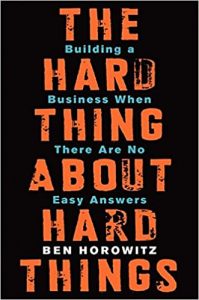
Tell it like it is – Don’t project a too positive picture. Should NOT be the only one worrying about the company, product, business. Builds trust. Gets more brains to work on the problem. Bad news travels fast in a good culture
Laying off the right way – get your head straight, don’t delay, be clear in your own mind why you are laying off people, train your managers, address the entire company, be visible be present
Everyone goes through The Struggle.
Calculus vs statistics – if there is just one option you have to pursue it with the same rigour inspite of the odds
No silver bullets. Just lead bullets. Fight/knuckle your way out of the situation. Fight it out.
Hire for strengths rather than lack of weaknesses. Especially in your leadership/executive team
Take care of people, product and profits – in that order. Meet 1:1 regularly
Training is the boss job. Andy Grove
Good product manager vs bad product manager – manifesto by Ben pg111
Hire for the right kind of ambition- more focused on company than self.
Peter Principle – in a hierarchy members are promoted so long as they work competently. Sooner or later they are promoted to a level that they are incompetent for
Law of crappy people – for any title level in a jig org, the talent on that level will eventually converge to the crappiest person with the title.
Culture – drive desired behavior. Eg desks from doors at Amazon. Ten dollar per min fine for late for entrepreneur meetings at VC firm
Organisation design : purpose of process is to drive communications. Steps to build an org design: 1. What needs to be communicated 2. What needs to be decided 3. Prioritise the most important comms and decisions 4. Decide who’s running each group 5.identify paths you didn’t optimise 6. Build a plan to mitigate risks in step 5
Basics of production- focus on th output first, figure out how you will know if you are getting what you want at each step, build accountability into the system
Focus on the road not the wall. Tip to manage a crisis or tough decision. Focus on where you are going rather than on what you hope to avoid.
Decoding leadership – ability to articulate a vision, right kind of ambition, ability to achieve the vision.
Peacetime and wartime CEO
Giving feedback – be authentic, come from the right place, don’t get personal, don’t clown people in front of others, feedback is not one size fits all, be direct not mean- watered down feedback is not effective
Give frequent feedback. People will get used to getting feedback and not read too much meaning into it. They will become comfortable discussing bad news.
Bad news travel fast and good news travel slow – Datta networking routing protocol
Strategy and the story – the Why of the co. the CEO is the keeper of the story. Rallies every stakeholder around the story.
CEO produces decisions- speed and quality of decisions. Needs intelligence, courage and logic
Ben Horowitz presents 2 distinctions, he calls them Ones and Twos.
Ones are the strategic CEOs, the visionaries, those who are excellent at finding a path the organisation can follow. They prefer making strategic decisions and aren’t hesitant to pivot the business when required to.
Twos favour execution and management over analysing and trying to make decisions. They are the practical CEOs, who love to implement, manage a team and achieve targets.
For a business to take off, you need to have enough of both qualities. Horowitz describes these as functional Ones, which are essential to have as executives also.
Make sure you teach yourself the part you don’t do as well, and if not, at least invite the right people for the job.
# Key Takeaways:
– The importance of being a “wartime” CEO and making tough decisions in difficult situations
– The need for clear communication and transparency with employees during challenging times
– The value of creating a strong company culture and hiring the right people
– The importance of constantly adapting and pivoting in a rapidly changing business landscape
– The role of a CEO in setting and maintaining company values and vision
– The need for resilience and perseverance in the face of failure and setbacks
# Practical Application:
The concepts and strategies presented in The Hard Thing About Hard Things can be applied in real-world scenarios by:
– Developing a strong decision-making framework for tough situations
– Communicating openly and honestly with employees, especially during times of crisis
– Prioritizing company culture and hiring individuals who align with the company’s values
– Continuously evaluating and adjusting business strategies to stay ahead of the competition
– Taking ownership of company values and actively promoting them within the organization
– Building resilience and learning from failures to drive future success.
# Valuable Insights for Leaders and Managers:
– Chapter 1: “From Wartime CEO to Peacetime CEO”
– provides valuable insights on the different roles and responsibilities of a CEO in different business environments.
– Chapter 2: “Creating a Good Place to Work”
– offers practical advice on building a strong company culture and hiring the right people.
– Chapter 5: “The Struggle”
– highlights the importance of perseverance and resilience in the face of challenges and failures.
– Chapter 9: “The Right Way to Lay People Off”
– provides guidance on how to handle difficult decisions and communicate them effectively to employees.
# Effective Case Studies and Examples:
– The story of how Ben Horowitz handled the difficult decision to lay off a large portion of his workforce during the dot-com crash.
– The example of how Andy Grove, former CEO of Intel, navigated the company through a major crisis and turned it into a successful business.
– The case study of how Mark Zuckerberg, CEO of Facebook, made tough decisions and pivoted the company’s strategy to stay ahead of competitors.
Leave a Reply